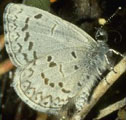Native Plants
Search for native plants by scientific name, common name or family. If you are not sure what you are looking for, try the Combination Search or our Recommended Species lists.
Viburnum opulus var. americanum
Viburnum opulus L. var. americanum Aiton
American Cranberry Bush, Highbush Cranberry, American Cranberrybush Viburnum, Cranberry Viburnum
Caprifoliaceae (Honeysuckle Family)
Synonym(s): Viburnum opulus ssp. trilobum, Viburnum trilobum
USDA Symbol: VIOPA2
USDA Native Status: L48 (N), CAN (N), SPM (N)
Highbush-cranberry is a 6-12 ft. shrub which can reach 16 ft. Dense upright or arching branches create a round outline. Maple-like, deciduous foliage is colorful in fall. White, flat-topped clusters of flowers are followed by persistent red berries.
Plant Characteristics
Duration: PerennialHabit: Shrub
Leaf Retention: Deciduous
Fruit Type: Drupe
Size Notes: Up to about 16 feet tall, often shorter.
Leaf: Green
Fruit: Red, Orange.
Bloom Information
Bloom Color: WhiteBloom Time: May , Jun , Jul
Distribution
USA: CT , IA , ID , IL , IN , KY , MA , ME , MI , MN , MO , MT , ND , NE , NH , NJ , NY , OH , PA , RI , SD , VT , WA , WI , WV , WYCanada: AB , BC , MB , NB , NS , PE , QC , SK
Native Distribution: Nf. to B.C., s. to NJ, n. IN, n. IL, Black Hills, WY & WA
Native Habitat: Cool woods; thickets; rocky shores; slopes
Growing Conditions
Water Use: HighLight Requirement: Part Shade
Soil Moisture: Moist , Wet
Soil pH: Circumneutral (pH 6.8-7.2)
CaCO3 Tolerance: None
Soil Description: Wet to average, well-drained loams.
Conditions Comments: Flood, disease and insect tolerant. Transplants easily. Edible berries.
Benefit
Use Wildlife: Songbirds, gamebirds, small mammals.Use Food: The berries make an excellent winter-survival food because they remain above the snow and are sweeter after freezing. (Kershaw)
Conspicuous Flowers: yes
Fragrant Flowers: yes
Attracts: Birds , Butterflies
Larval Host: Spring Azure
Butterflies and Moths of North America (BAMONA)
|
Spring Azure (Celastrina "ladon" )  Larval Host |
Propagation
Propagation Material: Hardwood Cuttings , Seeds , Softwood CuttingsCommercially Avail: yes
From the National Organizations Directory
According to the species list provided by Affiliate Organizations, this plant is on display at the following locations:Delaware Nature Society - Hockessin, DE
Mt. Cuba Center - Hockessin, DE
Bibliography
Bibref 1186 - Field Guide to Moths of Eastern North America (2005) Covell, C.V., Jr.Bibref 1185 - Field Guide to Western Butterflies (Peterson Field Guides) (1999) Opler, P.A. and A.B. Wright
Bibref 841 - Native Alternatives to Invasive Plants (2006) Burrell, C. C.
Search More Titles in Bibliography
Web Reference
Webref 23 - Southwest Environmental Information Network (2009) SEINet - Arizona ChapterAdditional resources
USDA: Find Viburnum opulus var. americanum in USDA PlantsFNA: Find Viburnum opulus var. americanum in the Flora of North America (if available)
Google: Search Google for Viburnum opulus var. americanum
Metadata
Record Modified: 2022-10-21Research By: TWC Staff